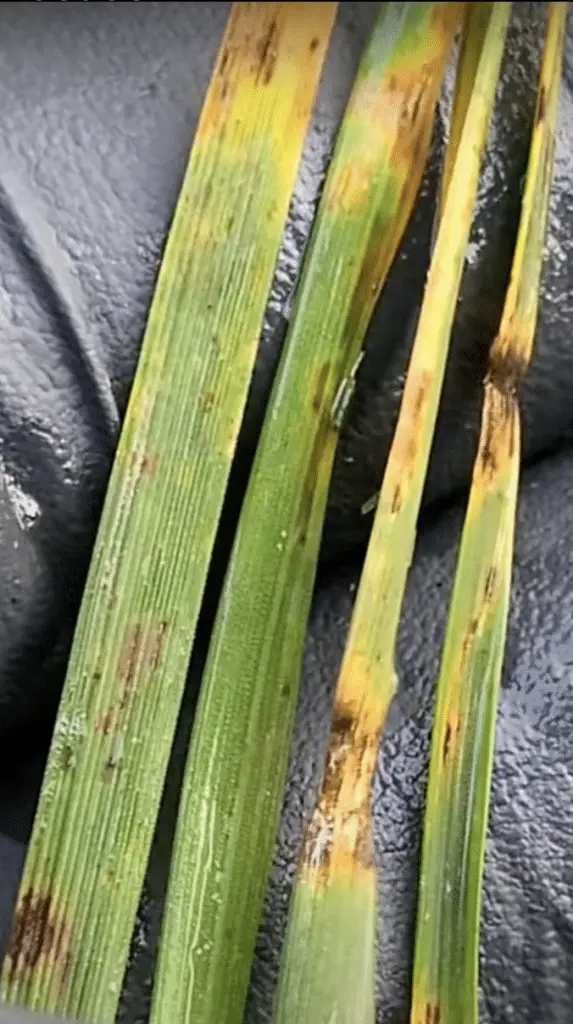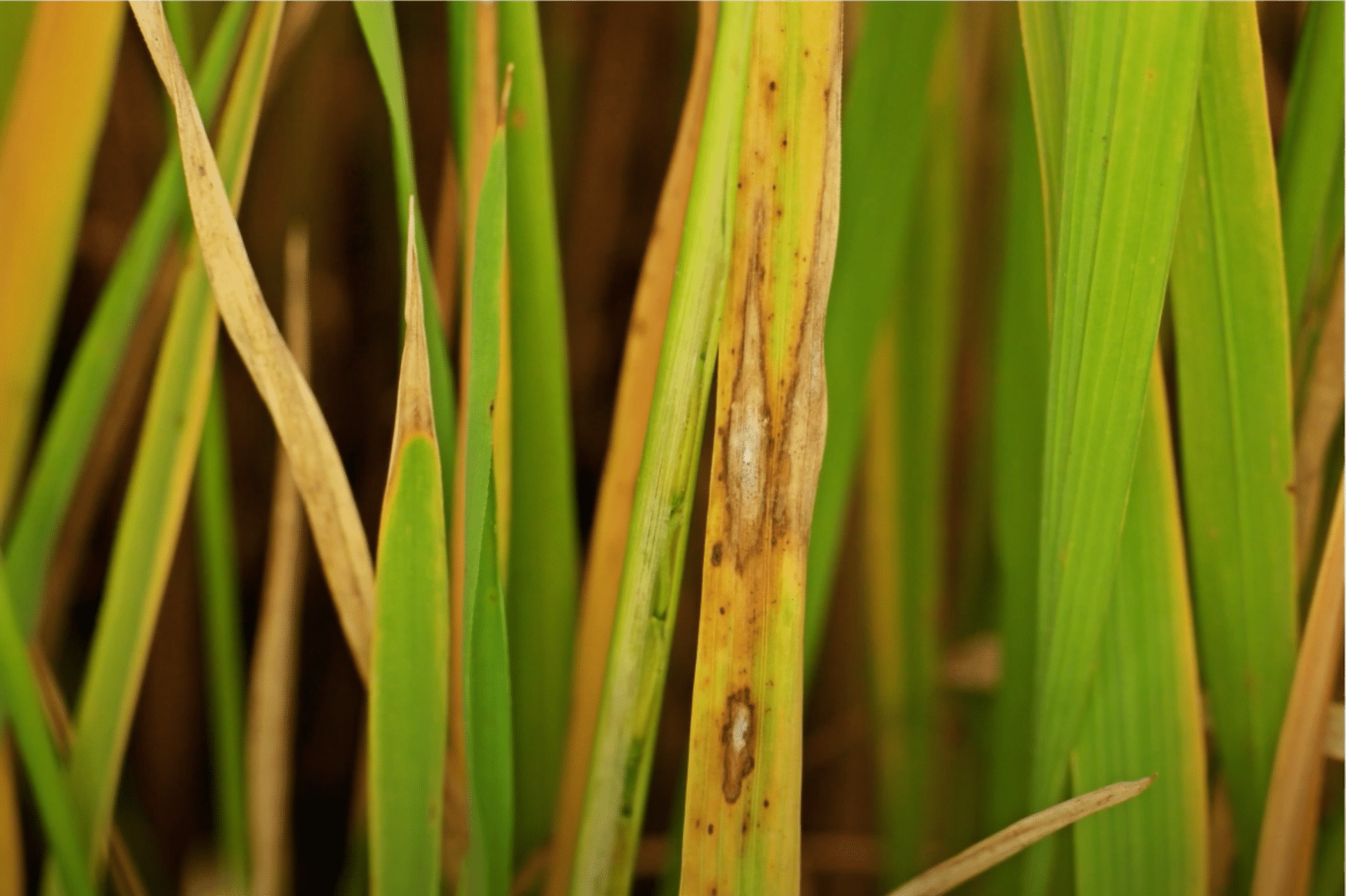LAWN PHIX PRO TIPS
Leaf spots in plants can result from various diseases, all exacerbated by high humidity. To combat them, one of the best cultural practices I continue to tell my customers is regular lawn mowing to promote air circulation. Leaf Spot disease leaves characteristic black-edged spots on affected leaves. For instance, grey leaf spot manifests as a grey spot with a black margin on grass blades, signifying disease spread.
For chemical control of leaf spot, I use professional-grade fungicides like Armada WDG or Talaris XL Fungicide. Still, rotating single AI fungicides like propiconazole and Azoxystrobin every 21 days will also work. These measures are essential in managing humidity-driven diseases like leaf spot and preserving plant health.
Leaf spot lawn disease is a common disease that affects bluegrasses and bermuda grasses, including Kentucky bluegrass, tall fescue, and ryegrass. The disease is characterized by brown or black spots that occur on the leaves or sheaths of the grass. The spots appear more like small flecks initially, but they expand. As they expand, the spots appear encircled by a yellow ring. Ultimately, the disease can cause the affected grass to yellow, wilt, and die. Leaf spot lawn disease is caused by different types of fungi of the Helminthosporium species and typically plagues lawns during the humid weather and heat of summer.
Unfortunately, if leaf spot lawn disease is not controlled quickly, it can do significant damage and even destroy bermuda and bluegrass lawns. Here, we’ll explore this grass blade disease in detail as well as how to prevent leaf spot.
Table of Contents
Leaf Spot Lawn Disease in Detail
Though often referred to as melting out disease, leaf spot and melting out differ slightly even though symptoms of both diseases greatly overlap. Leaf spot infection does feature a melting out phase, but this infection spreads during the summer and its hot, humid weather whereas melting out disease occurs during cooler, wet weather. While many lawn diseases occur during hot weather and drought stress, leaf spot infection is definitely one you want to control in its early stages.
Fortunately, the telltale symptoms of leaf spot occur in the early stages of the disease. That’s when you’re likely to note the presence of leaf lesions–those brown or black spots and yellow halo effects mentioned above. If you spot these leaf spot symptoms, you’ll want to take measures to control the disease, which we’ll discuss in just a bit.


What Causes Leaf Spot Disease?
The fungus types that cause leaf spot disease are readily present in soils. However, disease activity isn’t likely to progress unless certain environmental conditions occur. Bluegrass lawns, for instance, are vulnerable to leaf spot in shady areas or suffer from poor air movement. Soil that’s deficient in nitrogen can also leave turfgrass species more susceptible to lawn diseases. Factors like excessive thatch, drought stress, soil compaction, poor water drainage, insect damage, and frequent mowing (especially mowing at a low grass blade height) can contribute to leaf spot disease development.
Leaf Spot Disease Control and Treatment
The key to controlling leaf spot disease successfully is to catch it as soon as possible. Begin to inspect your lawn periodically in early spring and certainly throughout summer’s hot weather to search for signs of leaf spot disease development. Investigate any leaf spots on grass blades to identify this lawn disease. Remember to look for tan centers, yellow halo effects, and random patterns, all associated with the melting-out phase of the disease.
You can treat affected areas with cultural control or chemical control. Cultural control is possible, given that there are disease-resistant cultivars of turfgrass species. Overseed using these cultivars for good long-term control of leaf spot disease. When caring for your lawn, reduce leaf wetness. Water deeply but infrequently. Be sure to reduce thatch and aerate your lawn frequently.
Use sharp blades and a clean lawn mower deck, and catch/bag your clippings when mowing. Returning the cut grass back into the lawn can potentially spread the disease.
If you choose lawn fungicide applications, you must apply them early in the leaf spot infection. If the disease reaches the melting-out phase, fungicides are unlikely to cure it. However, fungicides may help prevent leaf spot from spreading to other areas of the lawn.
Like most lawn diseases, including summer patch and brown patch, for leaf spot and melting out, we like Artavia 2SC (Azoxystrobin), Eagle 20EW (Myclobutanil), and Propiconazole 14.3. Rotate the fungicides after every 1-2 applications to prevent lawn fungicide resistance.
Leaf Spot Lawn Disease FAQs
Will leaf spot disease go away?
Leaf spot disease is unlikely to simply ‘go away.’ However, with proper care, this lawn disease isn’t likely to destroy your lawn providing you confront the disease before it reaches the roots of the grass blades. Typically, leaf spot disease makes the lawn appear to be sick–and it is. But it’s precisely at this point that the disease is quite treatable. Remember that once melting out occurs, the disease will be more difficult to control with just fungicide applications.
What kills leaf spot fungus?
Fungicides can kill Helminthosporium diseases like leaf spot. Planting disease-resistant bluegrass lawns or bermuda grass lawns can help you prevent leaf spot from affecting your grass.
What is leaf spot disease caused by?
Leaf spot disease is caused by fungi of the Helminthosporium species. This species tends to thrive and affect lawns during hot weather.

